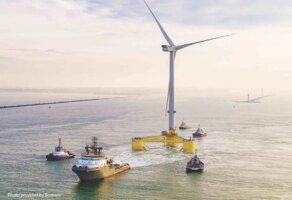Scottish energy company ScottishPower Renewables says it has achieved a “pioneering world first” by using power from the Dersalloch wind farm to re-energise a blacked-out section of the country’s power grid.
ScottishPower, a subsidiary of Spanish energy giant Iberdrola, which has recently taken control of listed Australian renewable energy and storage company Infigen, says the use of a wind farm as part of a black-start restoration process is a world first.
A “black start” is the name given to the procedure used to restore power in the event of a total of partial shutdown or blackout of the electricity transmission system. Black-Start restoration has historically been reliant on traditional fossil fuel generation, such as coal-fired or natural gas.
However, by using “grid-forming” technology called virtual synchronous machines (VSM) to regulate the frequency and voltage of the power from the turbines – which essentially turned the Dersalloch wind farm into a stable network island – ScottishPower was able to keep the electricity system stable and balanced.
“What we’ve achieved at Dersalloch is truly world-leading and highlights the crucial role renewables will play in creating a decarbonised modern, smart electricity system,” said Lindsay McQuade, CEO of ScottishPower Renewables.
“It’s also a fantastic example of collaboration and innovation to deliver something exceptional that will change how renewables interact with the grid forever. It’s no longer just about the raw power we generate, but the interplay of renewable generation and its characteristics with the overall grid system and its requirements for when power is needed and used.
“As wind is now the cheapest form of electricity generation, innovating our windfarms to be responsive zero-carbon power stations that enhance the network, improve system resilience and help deliver the cleaner and greener future needed to achieve net zero makes sense.”
The 69MW Dersalloch wind farm was completed in 2016 and consists of 23 Siemens 3MW wind turbines.
The project to provide Dersalloch with the necessary capabilities to act in a Black-Start situation saw ScottishPower Renewables (SPR) partner with Siemens Gamesa Renewables Energy (SGRE) to deploy the latest technology necessary to regulate the wind farm’s frequency and voltage.
The project also received partial funding from the Scottish government.
“Over the past decade Scotland has delivered huge success in decarbonising the electrical energy generated in Scotland, with renewable electricity delivering the equivalent of more than 90% of the power needed to meet Scotland’s demand for electricity in 2019,” said Paul Wheelhouse, Scotland’s Energy Minister.
“It is important that wind farms, which provided 73% of Scotland’s renewable electricity generation, don’t only provide zero carbon energy, but can also deliver the technical services that older, now-closed power stations would have provided for the grid to deliver an effective ‘black start’ recovery in the event of a major power cut.”
SPR and SGRE also worked in conjunction with SP Energy Networks (SPEN), the Distribution and Transmission network Operator for parts of Scotland, Wales, and England. SPEN provided access to the grid when it was time to provide Black-Start power.
Partnership with SPEN allowed the regional operator the opportunity to gain knowledge as to how many wind turbines would need to be connected prior to attempting switching of the largest transformers and longer lines, which would be necessary to recover the wider network following a ‘black start’ event.
“Our involvement in this project has been invaluable and showcases how we can get the network started and put the lights back on using renewable energy sources,” said Frank Mitchell, CEO of SP Energy Networks.
“There is no doubt this technology can make an important contribution to our restoration strategy in the event of a ‘black start’, by building on work we are doing elsewhere across the energy system to ensure security and resilience of supply is maintained throughout the energy transition. I believe that, to provide the resilience required, all windfarms should be established with this capability in future.
“That’s a significant step change and one that takes us closer to delivering the green and resilient grid system we all need and want,” Mitchell continued.
“It is also testament to the innovative approach that’s at the heart of everything we do at SPEN as we work to design and deliver the network of the future – the network that will help deliver Net Zero.”










